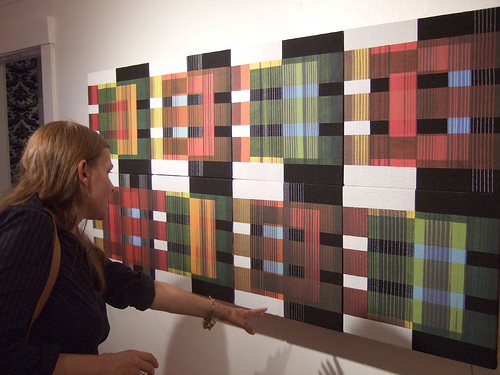[gallery] I met with Maggie Orth of International Fashion Machines today in her Seattle studio. After walking in and being incredibly awestruck and inspired by the work that she has strung around her studio, we had a terrific conversation about wearable technology, the challenges, the realities, and possible opportunity areas for aspiring wearable technology designers.
A large portion of the discussion was around the challenges of designing wearable technology solutions and taking them to market. There are so many challenges across many industries that will require re-tooling, rethinking and new processes that are involved with integrating technology into our clothes. Here are just a few of the thoughts that we discussed:
- The fashion industry has quick and seasonal product cycles. In the fashion industry, there is a short quarterly product cycle based on the seasons. If wearable technology is going to be successful, it needs to adapt and be flexible to this schedule.
- Manufacturing requires some retooling. There are manufacturing challenges. Retooling will need to occur to integrate the technology efficiently into the manufacturing process.
- The price is too high. The price of smart fabrics and integrated technology is high right now and the market isn't ready to drive the cost down. Designers need to think of real solutions that can target large and broad markets with high-volume orders that result in driving cost down and making the product more cost effective
- A matter of sustainability. Electronics are not the most sustainable and eco-friendly materials. Clothing is usually a short-term product. If we integrate technology, we (wearable technology designers) should consider the end-to-end cycle of the product and the materials that are going into them.
- A matter of need vs. innovative solution. We discussed ideas that are currently out there and challenged the level of innovation. Have we really seen solutions that are truly useful, innovative, and marketable?
- Materials that solve the basics. The materials are just not there yet. As an example, we discussed the lack of really good display solutions for wearables, talked about the lifecycle of e-ink and flexible displays. We are just not there yet. And we discussed when we think we will be.
- A strong business model. There are many different strategies that can be taken towards creating a real product-based and business-sustainable wearable technology company or product. We identified a few opportunity areas in this space but discussed the challenges of a sustainable business model that we have yet to see.
Overall, from manufacturing techniques to basic materials to business models, each of the areas that we discussed are non-trivial challenges, but also terrific opportunity areas for innovation in this space. In the end, however, we ended our conversation with the notion that it will take a significant cross-industry effort to reach a broad commercial audience. I believe we'll get there. Somehow.
In addition to our discussion, Maggie showed me some of her latest explorations with her gorgeous color-shifting fabric panels, which you can see in the photos. She has spent years developing a "secret sauce" to her thermochromatic ink that gives it the most vibrant saturated colors. She is also exploring the possibilities of exposing the electronics to help tell a richer story about the work.
Maggie showed me a few animated patterns that were breathtaking. You can see the detail of the hand-woven textile and the complexity of the patterns that the ink and colors make. She has truly created some amazing textural pieces that tell a rich story that also evolve over time. I can't wait to see more.
